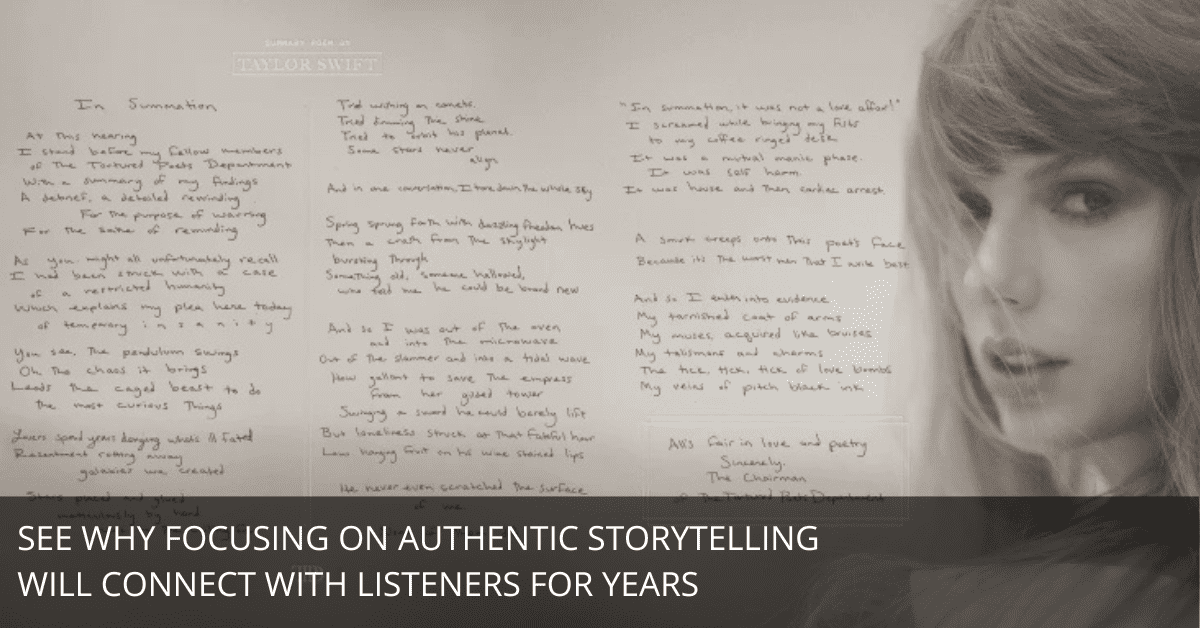
It’s easy to get swept up in the pursuit of a "hit"—that elusive song that blows up the charts and gets everyone humming along.
But for a songwriter, aiming for hits can actually be a distraction from what really matters: creating songs that resonate deeply, stand the test of time, and keep people coming back.
Taylor Swift, one of the most successful songwriters of her generation, didn’t build her career by chasing trends or following formulas. Instead, she crafted a career through the art of storytelling.
Storytelling is What Lasts
A hit song can fade quickly, but a well-told story? That’s timeless. When you focus on storytelling, you give your audience more than just a catchy melody or a memorable chorus. You’re offering them an experience, a slice of emotion, or a moment they can see themselves in.
For example, take Swift’s "All Too Well." While it wasn’t originally a chart-topping single, fans kept the song alive for nearly a decade because of its honest, vivid storytelling. When she re-released it as a 10-minute version, the song exploded in popularity, showing just how powerful a good story can be. Instead of chasing hits, aim to write stories people will want to hear again and again.
How Swift Uses Story Structure
Swift doesn’t just toss out lines and hope they stick; she uses structured storytelling techniques. Think of each verse as a “chapter” that drives the song forward. Her songs often have a beginning, middle, and end, giving listeners a complete story arc within a few minutes. For example, "You Belong With Me" isn’t just a song about unrequited love; it’s a narrative where each verse builds a detailed story of longing, comparison, and, ultimately, a quiet declaration of love.
To do this, try structuring your song with a clear progression. Start with a setting in verse one, build tension or conflict in verse two, and resolve (or complicate) in the chorus or bridge. This approach helps listeners get invested in your story and stay engaged from start to finish.
Make It Personal, Make It Universal
Taylor Swift’s stories are personal, but they resonate on a universal level. She takes moments from her own life, whether it’s a breakup or a new romance, and finds ways to describe them that feel familiar to anyone listening. In "Lover," Swift turns a profoundly personal relationship into a universal love song. Lines like "Can I go where you go?" capture something we’ve all felt in relationships—wanting to be close and stay connected.
When you’re writing, look for specific details in your own life that might resonate broadly. Instead of saying, "I miss you," try describing a vivid memory of that person. What did they do that made them unique? Use concrete images like how their laugh filled up a room or the smell of their jacket. You’ll help your audience connect on a much deeper level by grounding your stories in real details.
Using Imagery to Paint a Scene
One of the reasons Swift’s lyrics stick with listeners is her use of rich, specific imagery. She doesn’t just tell us what she’s feeling; she shows us. In "Red," she describes a relationship as "like driving a new Maserati down a dead-end street." That single line evokes the excitement and ultimate futility of the experience—creating a memorable image that’s hard to shake.
To incorporate this into your own songwriting, think of a moment or feeling you’re trying to capture, and then imagine it as a scene in a movie. What does it look like? How does it smell? Is there a specific sound or color that represents it? For example, if you’re writing about heartbreak, you might describe the "hollow echo of footsteps down a quiet hallway." These sensory details bring your listeners into the world of the song and make it feel real.
Emotion First, Melody Second
If you start with a melody, it can be tempting to fit words to match the rhythm. However, Swift often begins with the emotion she wants to convey and lets that guide the melody. She’s not afraid to let her lyrics dictate the song’s direction, even if it means breaking out of a predictable song structure. Songs like "All Too Well" and "The Archer" are emotionally driven, with melodies that ebb and flow to match the narrative rather than sticking to a strict pattern.
To try this, focus first on the feeling you want to convey. Write out some lines or phrases that capture that emotion, even if they don’t rhyme or fit a traditional melody. Then, start shaping the music around those words. This process might take longer, but it often results in a song that feels much more authentic.
Be Willing to Take Risks
One reason Taylor Swift’s storytelling stands out is her willingness to experiment. She’s shifted from country to pop, to indie folk and even added electronic influences, adapting her songwriting to suit the genre each time without losing her narrative voice. The lesson here? Don’t be afraid to step outside your comfort zone. Sometimes, a change in genre or style can open up new ways of telling your stories.
Experiment with different musical elements, or try writing in a style that challenges you. If you typically write love songs, tackle a darker theme. If you always use the same rhyme schemes, switch them up. Storytelling isn’t just about what you say—it’s about how you say it. Swift’s fearlessness in trying new things shows that a good storyteller can adapt and evolve while staying true to their voice.
Give Your Song a Message, Not a Moral
Swift’s songs rarely try to teach you a lesson. Instead, they offer an observation, a snapshot of a moment in time. In "Blank Space," she pokes fun at her reputation and the idea of “serial dating” with wit and a touch of sarcasm, allowing the listener to draw their own conclusions. By focusing on the moment rather than the moral, she creates a more engaging story that invites listeners to interpret it in their own way.
To apply this to your writing, resist the urge to wrap up your song with a lesson or moral. Instead, focus on capturing the moment as honestly as possible. Let listeners feel the tension, the joy, or the uncertainty without telling them how to interpret it. The best stories are the ones that let us come to our own conclusions.
Keep Writing, Even When It’s Not Perfect
Swift’s career longevity comes from her consistency. She keeps writing, releasing, and refining. Some of her songs are breakout hits, and others are fan favorites. But her commitment to storytelling keeps her career thriving, even when it means releasing a song that may not dominate the charts.
So, keep writing. Don’t worry if every song isn’t perfect or if it doesn’t catch fire right away. Treat each song as a chance to connect with listeners to tell a story that matters to you. Over time, you’ll build a rich, varied, and meaningful body of work—just like Taylor Swift.
Ultimately, songs that resonate with listeners aren’t always the ones that hit the top of the charts. They’re the songs that tell stories we recognize and make us feel something real. Write those songs, and the success will follow.

